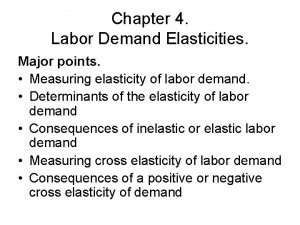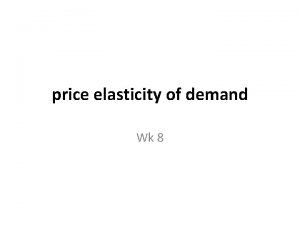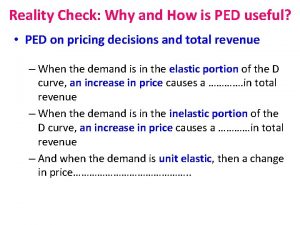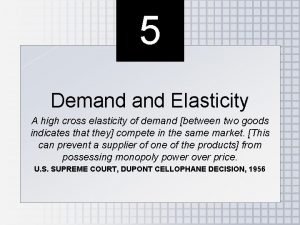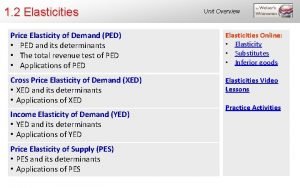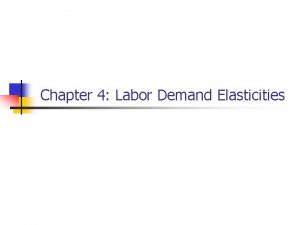Cross Elasticity of Demand Cross elasticity of demand






- Slides: 6

Cross Elasticity of Demand • Cross elasticity of demand measures the responsiveness of the quantity demanded of one good to a change in the price of another. • If a price or quantity decreases a negative is used in the calculation. These are essential to cross calculations but not for Price Elasticity of demand. • The calculation of cross elasticity of demand helps to determine whether a relationship exists between the two goods e. g. substitutes or complements or no relationship at all.

Calculations • Midpoint method • (Quantity) ∆Quantity (product B) divided by {Quantity B 1 + Quantity B 2 }divided by 2 (average of quantity). • Divided by the price • ∆Price (product A) divided by {price A 1 + Price A 2} divided by 2 (average of price).

Percentage change method divided %∆Quantity product B % ∆Price product A • Percentage change = Difference divided by Original x 100. • Calculate the percentage changes for each quantity and price then divide quantity by price.

Cross Elasticity of Demand • Once an answer is calculated: • A negative answer = Complement relationship e. g. an increase in price of good A will result in a decrease in quantity demanded of good B i. e. petrol and cars. • A positive answer = Substitute relationship e. g. an increase in the price of coke will result in an increase in the quantity demanded of Pepsi. • A 0 (zero) answer = no relationship at all. E. g. an increase in price of bananas does not influence the quantity demanded of newspapers. The two are independent.

Example • Good A has an increase in price from $1. 30 to $1. 50, following which Good B has a fall in sales from 200, 000 to 190, 000 units. • -10, 000 divided (200, 000 + 190, 000) / 2 • + 0. 20 divided (1. 30 + 1. 50) / 2 • = -0. 052631578 / 0. 142857142 • =-0. 368421048 • Negative = complement • Positive = substitute • 0 = no relationship

1. Instant coffee and plunger coffee. The price of plunger Example coffee rose by 12% sales of • Bananas and grapes instant coffee rose by 5% • Bananas fell from $2. 00 kg to 1. 60 kg sales of grapes 2. Rat poison and ginger beer. The price of rate poison rose fell 4% • Percentage change in by 8% sales of ginger beer price = -40 c / 2. 00 x 100 rose by 0. 02%. • % Q divided by % P 3. Good C was reduced in price = 4% / -20% = -0. 2 by 9%, following which sales • This calculation shows of Good D went from 2. 3 these goods to be complements. million to 3 million units. • They may not necessarily 4. Good D increased prices from meet the requirements $16, 500 to $18, 000. At that for this but the example time Good F reported a assumes they are. increase in the level of sales.
